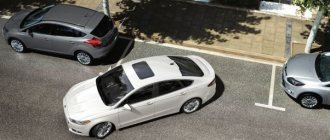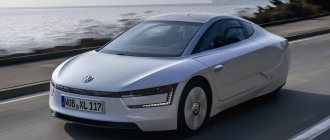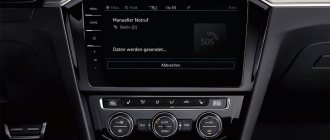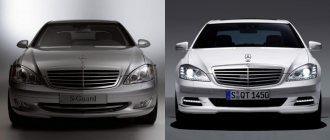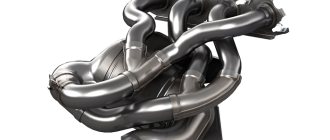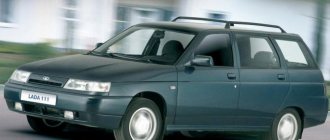Standards and sizes of passenger cars by segment
The classification of the Economic Commission for Europe is focused on segmenting the target market, and the boundaries between segments are more blurred and are not limited to parameters such as dimensions or weight, but also include price, type, set of options, etc.
Segments are often used by manufacturers to define a vehicle's place in the market, but specific vehicles within a segment often have vastly different features, technologies, and options depending on the manufacturer.
The boundaries between classes are quite arbitrary and are gradually blurring as automakers strive to give customers “more car” for the same money. When updating the model, it became a sign of good form to increase its length by 10-15 centimeters, as well as add functions that previously could only be offered by more expensive classes.
According to the European classification, all passenger cars belong to one of six segments:
| Designation | Length, m | Width, m | Name |
| Segment A | up to 3.6 | up to 1.6 | Mini cars (“especially small class”) |
| Segment B | 3.6—3.9 | 1.5—1.7 | Small cars (“small class”) |
| Segment C | 3.9—4.3 | 1.6—1.7 | Medium cars (“middle class”, “golf class”) |
| Segment D | 4.3—4,6 | 1.69—1.73 | Larger cars (“big class”) |
| Segment E | 4.6—4.9 | 1.73—1.82 | Executive cars (“business class”) |
| Segment F | more than 4.9 | more than 1.82 | Luxury cars (“executive class”) |
In addition, there are several separate groups of cars that do not fit into any of the segments described above. For such cars, three additional segments are allocated:
| Designation | Vehicle type |
| S segment | Sports cars, coupes, convertibles |
| Segment M | MPV - Minivans, high-capacity station wagons |
| Segment J | SUV - Sports-utilitarian cars, crossovers, SUVs |
Segment A
Extra small class, supermini, city car
- the smallest cars designed for cramped city conditions. Dynamic and driving characteristics are often mediocre. Body type: 3-door or 5-door hatchback. The length of the car is up to 3.6 meters and the width is up to 1.52 meters. Such models are attractive for their efficiency and parking capabilities in limited city spaces.
Typical representatives of the class: Daewoo Matiz, Kia Picanto, Chevrolet Spark, Ford Ka, Renault Twingo, Peugeot 107, Opel Adam, Toyota iQ, Suzuki Splash, Hyundai Eon, Chery QQ, Citroen C1, Suzuki Wagon R.
What is the average width of a car?
It is necessary to know the average width of a passenger car; both experienced motorists and automotive industry specialists talk about this.
To correctly calculate the average width, you need:
- Know how many meters the car will occupy with the doors open. Doors can be of different lengths, depending on the model. Therefore, when building or choosing a garage space, you definitely need to know how many meters the car will occupy in width with all doors open.
- It is necessary to leave an additional 1-2 m so that the driver and passengers can easily get into and out of the car.
- If the opportunity to make a long garage near a private house is limited, then an additional 0.5-1 m for shelves or racks should also be added to the calculation of the width. They are always necessary in a functioning garage. Even if the car will only “spend the night”.
If you decide to build a garage yourself or make a full-fledged extension for this, you need to take into account all the dimensions, the necessary additional meters, etc. In addition, if you need to build a garage for a minibus, you must also take into account its height
It will be larger than the average passenger car.
Before building a garage for one or more cars, you should draw up and draw a plan for the future premises, taking into account all additional and basic parameters, as well as the dimensions of the entrance gate and, if necessary, a gate.
Segment B
Small class
- a popular class of small-sized cars in Europe. In addition to 3 and 5-door hatchbacks, they are occasionally produced in sedan and station wagon bodies. Length up to 3.9 meters, width up to 1.7 meters. Engine displacement usually does not exceed 1.6 liters.
Typical representatives of the class: Audi A1, Nissan Micra, Volkswagen Polo, Skoda Fabia, Seat Ibiza, Hyundai Accent, Fiat Punto, Opel Corsa, Peugeot 208, Renault Clio, Renault Symbol, Ford Fiesta, Toyota Yaris, Mini, Mazda 2, Citroen C3 , Citroen DS3.
Load capacity
The overall dimensions of Gazelle cars place them in the lightest category. Their carrying capacity is 1.5-1.7 tons.
Minibuses have a slightly larger carrying capacity (1.5-2 tons). These machines develop quite good speed and allow the freight forwarder to accompany the cargo in the driver’s cabin.
The next category includes trucks of domestic and foreign production. Their carrying capacity is in the range of 3.5-7 tons. Their body can be tent or all-metal. They are used both for movement within the city and between them.
The next class is 10-ton trucks. They are also divided into subgroups. The first of them includes vehicles with a carrying capacity of 5-10 tons and a body volume of up to 36 cubic meters. m. The second group is also characterized by a tonnage of up to 10 tons, and their compartment volume is up to 56 cubic meters. m. The overall dimensions of KAMAZ vehicles are most suitable for the third group. Their carrying capacity is 10-15 tons, and the body has a volume of up to 60 cubic meters. m.
The next category unites vehicles with a carrying capacity of 20 tons. The container of such vehicles is called sea. It comes in 20 or 40 pound sizes. In the second case, the carrying capacity increases to 28 tons.
“Eurotents” are distinguished as a separate group. These are semi-trailers with a carrying capacity of 20-22 tons.
Segment C
Golf class, compact class
- universal, relatively compact, but more spacious cars, also classified as the “lower middle” class. The segment is the most popular in Europe (about a third of all sales). For decades, the trendsetter here was the Volkswagen Golf, which is why another name became the expression golf class. The capacity of golf-class cars allows you to transport five adults with luggage, but three people in the back seat will be cramped. Length up to 4.3 meters, width up to 1.7-1.8 meters.
Body types - hatchback, sedan, station wagon. Less commonly - coupes and convertibles (however, according to the European classification, convertibles can belong to other segments, regardless of size). Dynamic and speed qualities vary widely, comfortable for trips and travel.
Typical representatives of the class: BMW 1-Series, Volkswagen Golf, Ford Focus, Audi A3, Renault Megane, Opel Astra, Peugeot 308, Honda Civic, Toyota Corolla, Toyota Auris, Nissan Almera, Kia_cee'd, Kia Cerato, Mazda 3, Hyundai Elantra, Hyundai i30, Mitsubishi Lancer, Volvo V40, Citroen C4, Citroen DS4, Skoda Octavia, Subaru Impreza, Suzuki SX4, Chevrolet Cruze.
Hitting
The hitting exercise is also not difficult, but you need to have good practice in order to repeat the results obtained without errors. You need to place an empty plastic bottle on the platform, and take turns running over it with your front wheels. It seems that everything is easy, but this is a mistaken opinion. Beginners often miss. When you do the exercises effortlessly, make it more difficult by adding speed when hitting. To consolidate the exercise you have learned, do a run on an empty area at a speed of 60 km/h. This condition will require the correct sense of size. If you exceed the specified speed, you have every chance of finding yourself in a dangerous emergency situation. At the third stage, you need to run over the bottle and simultaneously make a turn. Even savvy car owners make mistakes when performing this exercise. This complexity helps to achieve high results. It is not necessary to use a bottle; it is enough to replace it with an object that makes a loud sound and is easily compressed, but in no case should it fly out from under the wheels. A cardboard box folded in half can be an excellent substitute.
Segment D
Middle class
- middle or family class, presented in hatchback, sedan, station wagon bodies, with spacious interiors and voluminous trunks. This segment is usually divided into ordinary family models and luxury models, which, according to other classifications (for example, British) are allocated to a separate compact executive car segment.
Typical representatives of the class: Chrysler 200, Honda Inspire, SAAB 9-3, Opel Insignia, Peugeot 508, Mazda 6, Ford Mondeo, Toyota Avensis, Hyundai Sonata, Renault Latitude, Volkswagen Passat, Kia Optima, Audi A4, BMW 3, Mercedes- Benz C-Class, Lexus IS, Volvo S60, Citroen C5, Citroen DS5, Suzuki Kizashi, Subaru Legacy.
Dimensions of a garage for 1 car: optimal parameters
As a rule, most families in our country have one car, so most often motorists wonder what the optimal standard dimensions of the garage and car to take as a basis in order to build the most convenient garage.
What indicators should a garage meet:
- Place the car so that you can move around it without problems and have access to its bottom.
- The ceiling must be high so that it is possible to work with the roof of the car, for example, to install additional space on it for transporting things, bicycles, etc. In addition, the height of the garage can be important for convenient washing of the car.
- Strict consideration should be given to all necessary work surfaces and shelving, cabinets, tool racks, for any work to straighten small dents or to replace supplied vehicle parts.
- You should also take into account the presence of a repair hole or elevation under the bottom of the car.
Once the plan is completely ready, then all the surfaces, boxes, shelving and other necessary additions necessary for the motorist have been taken into account. After drawing up a plan, where all the necessary space has already been taken into account, you can look at what materials to use, whether to insulate or not, what kind of lighting equipment there will be, and also whether the garage should accommodate any functionality other than what is necessary for operating and repairing the car.
Thus, it becomes clear why there is an urgent need to know exactly what dimensions the car will have if the garage is already ready. If the garage is still only at the design stage, you can use averaged data. You can calculate them yourself, knowing the minimum dimensions of one desired car model and the maximum dimensions of another proposed car.
Segment E
Business Class
- usually sedans and station wagons. The cars have a spacious interior and a high level of standard equipment. The length is usually over 4.6 meters.
In Europe, predominantly luxury brands operate in this segment, and typical representatives are: Cadillac CTS, Jaguar XF, Saab 9-5, Volvo S80, Audi A6, BMW 5, Mercedes-Benz E-Class, Lexus ES. However, mass manufacturers also produce or have produced cars in this segment: Toyota Avalon, Citroen C6, Hyundai Grandeur, Kia Cadenza, Holden Commodore, Hyundai Genesis, Geely SL
F-class
Large vehicles with an overall body length of more than 5000 mm and a width of more than 1800 mm. Luxury sedans, premium crossovers and executive SUVs are at the same time the flagships of the manufacturer’s model line. Powerful engines, maximum comfort, rich equipment, high-quality finishing materials, advanced technologies and innovations - all these are attributes by which the premium class .
All cars, in parallel with the classification by class, can be divided into several price segments. Inexpensive or budget cars, mid-priced cars, business class cars, premium and exclusive cars.
Segment M
The M segment includes cars with a minivan body. The cars are intended mainly for large families, and can also be used for travel, as office delivery vehicles, etc. Capacity is from 5 to 7 seats, and minivans have up to 9 seats, including the driver. With the rear seats folded down or, in some cases, removed, vehicles in this segment can be used for cargo-passenger transport.
In terms of driving and speed characteristics, they are close to ordinary passenger station wagons. Minivans - unified in body and chassis with light cargo-passenger trucks, are distinguished by greater capacity, have sliding doors and an impressive height.
Representatives of the class: Ford Galaxy, Hyundai H-1, Fiat Doblo, Volkswagen Caravelle.
Why do you need to feel the dimensions of your car?
The car is a source of increased danger. In addition to the high speed of movement, it has certain dimensions, the boundaries of which are difficult for a novice driver to perceive. Therefore, beginners experience problems when driving through narrow sections of the road or parking, causing minor collisions with other road users, surrounding road signs, various structures, parked cars and pedestrians.
Dimensions are the size of the car that is located outside the driver's field of vision. In order not to hit someone else’s car when parking or to competently avoid a pothole on the road, you need to be able to sense this parameter. The whole difficulty lies in the fact that in a driving school the future driver has too few practical lessons to learn to fully feel the dimensions of the car. Therefore, a candidate driver will have to learn this through experience after receiving his license.
It is important to be able to determine the position of the wheels relative to uneven roads. This ability is useful for the driver to drive safely on road surfaces that have potholes or dangerous bumps that can be avoided without reducing speed.
There are several cases where the ability to sense the dimensions of a car can really come in handy:
- rear or front parking;
- entry into the garage;
- driving through a narrow yard among parked cars;
- avoiding potholes on the roads;
The car owner should not only feel every point of the car, but also feel its body, considering it an extension of his body. There is some truth in these words - this is how you can master driving perfectly in a wide variety of situations.
Classification of passenger cars by size
| USA | Great Britain | RF | Segment | Euro NCAP 1997-2009 | Examples |
| Micromobile | Microcar | Motorized stroller | A-segment | Supermini | Isetta, Smart Fortwo |
| Subcompact | City car | City car | Chevrolet Spark, Volkswagen up!, Ford Ka, Peugeot 107, Kia Picanto, Fiat 500 | ||
| Supermini | Small class | B-segment | Volkswagen Polo, Ford Fiesta, Peugeot 208, Opel Corsa, Citroën DS3, Kia Rio | ||
| Compact car | Small family car | Golf class Small medium | C-segment | Small family car | Volkswagen Golf, Ford Focus, Peugeot 308, Opel Astra, Hyundai Elantra, Honda Civic, BMW 1 |
| Mid-size car | Large family car | Middle class | D-segment | Large family car | Volkswagen Passat, Ford Mondeo, Peugeot 508, Opel Insignia, Hyundai Sonata |
| Entry level luxury car | Compact executive car | Audi A4, BMW 3, Mercedes-Benz C-class | |||
| Full size car | Business Class | Full size car | E-segment | Executive car | Chevrolet Impala, Honda Accord, Holden Commodore |
| Mid-size luxury car | Business Class | Audi A6, BMW 5-Series, Mercedes-Benz E-Class | |||
| Full-size executive car | Luxury car | Executive class | F-segment | — | Audi A8, BMW 7-series, Mercedes-Benz S-class |
| Sports car | Sports car | Sports car | S-segment | — | Chevrolet Corvette, Porsche 911 |
| Gran Turismo | Gran Turismo | Gran Turismo | — | Jaguar XK, Maserati GranTurismo | |
| Supercar | Supercar | Supercar | — | Bugatti Veyron, Pagani Zonda | |
| Cabriolet | Cabriolet | Cabriolet | — | Mercedes-Benz CLK-class, Volkswagen Eos | |
| Roadster | Roadster | Roadster | Sports roadster | Audi TT, BMW Z4, Porsche Boxster | |
| — | Recreational vehicle | — | M-segment | Small minivan (MPV) | Peugeot Partner, Škoda Roomster |
| — | Mini minivan MPV | Microvan | Ford B-Max, Opel Meriva, Honda Fit | ||
| Compact minivan | Compact minivan, mid-size minivan | Compact van | Ford C-Max, Opel Zafira, Volkswagen Touran, Renault Scenic | ||
| Minivan | Large minivan | Minivan | Large minivan | Ford Galaxy, SEAT Alhambra, Chrysler Town & Country, Mazda5 | |
| Mini crossover / SUV | Mini 4x4 | — | J-segment | Small off-road 4x4 | Mitsubishi Pajero, Suzuki Jimny |
| Compact crossover/SUV | Compact 4x4 | Compact crossover | Jeep Liberty, Honda CR-V, Kia Sportage, Toyota RAV4 | ||
| — | Crossover coupe | Off-road coupe | — | BMW X6 | |
| Mid-size crossover/SUV | Big 4x4 | Medium SUV | Large off-road 4x4 | BMW X5, Jeep Grand Cherokee, Volkswagen Touareg | |
| Full-size crossover/SUV | Heavy SUV | Cadillac Escalade, Chevrolet Suburban, Range Rover, SsangYong Rexton, Toyota Land Cruiser | |||
| Mini pickup | Pickup | Pickup | — | Pickup | Chevrolet Montana, Fiat Strada |
| Mid-size pickup | Chevrolet Colorado, Ford Ranger, Mitsubishi Triton/L200, Nissan Navara | ||||
| Full size pickup | Dodge Ram, Ford F-150, GMC Sierra, Nissan Titan, Toyota Tundra | ||||
| Giant pickup truck | Chevrolet Silverado, Ford Super Duty, Ram Heavy Duty |
Specialized trucks
Specialized cargo vehicles include tanks, dump trucks, refrigerators, tractor-trailers and semi-trailers, and vans.
Thermal trucks have a load capacity of 5-15 tons.
Insulated containers with 20 and 40 pound containers are in a separate category. Their carrying capacity is 15 and 20 tons, respectively.
Timber carriers (from 3 to 25 tons), steam locomotives (up to 15 tons) and tank trucks (12-24 tons) are also considered a separate group.
Landmarks
We offer you several guidelines to help novice drivers. So, to prepare special markings inside the car, you will need a flat asphalt area, chalk and adhesive tape:
- Park your car in a specific area.
- Use chalk to draw lines forward from the front and rear wheels. They should be quite long, since you will need to view them while sitting in the cockpit.
- After you have drawn the lines, take a seat in the driver's seat. Make yourself comfortable, as if you are about to travel. Now mentally continue the line from the wheels through the hood to the front panel.
- Place a piece of duct tape at the point where it intersects with the windshield. Do the same with the rear wheels.
Such landmarks will help you understand where the wheels are heading when driving. Once you begin to feel the size of your car, these colored stickers can be removed.
Peculiar landmarks for the end of the bumper are the installed antenna or “eyelashes for the headlights.” Using parking sensors or a camera will also be useful. If you have them installed in your car, follow their signals. This will greatly simplify the use of the car.
Tips for novice motorists
One of the main mistakes beginners make is trying to see what is in front of the car's bumper. This is fundamentally wrong, and this desire can lead to unexpected consequences. The driver must look only in front of him while driving.
Correctly setting the mirrors will help you park in reverse without any problems. They need to be adjusted so that the external mirrors reflect the wheels of the rear axle. Exterior mirrors monitor the sides of the vehicle. It is important to learn how to use them.
When driving on a highway outside the city, sometimes it happens that you inadvertently cut off a car driving from the side when changing lanes. To prevent this from happening, start your maneuver only when you can see the entirety of the adjacent vehicle in the side mirror.
Why is this happening
The first thing to do is evaluate the dimensions of the car when purchasing it. Some people will need an hour or two to figure out how to enter a parking lot or estimate the turning radius. Some people need months to develop confidence during the maneuver.
Perceived by sight through mirrors and glass. Refraction of real objects occurs. Therefore, it will take a lot of time to correctly assess the true distances to the rear bumper and the maximum nose reach of the car. With parking sensors and a camera, the task becomes much easier; the criterion of habit is no longer so important.
However, you should not completely trust the sensors. Often they “swallow” the signal and remain treacherously silent. And having gotten used to the dimensions of the car, a feeling of anxiety will arise in the wrong situation, when a pole or high curb is very close, and the parking sensors are completely calm and there are no objects.
